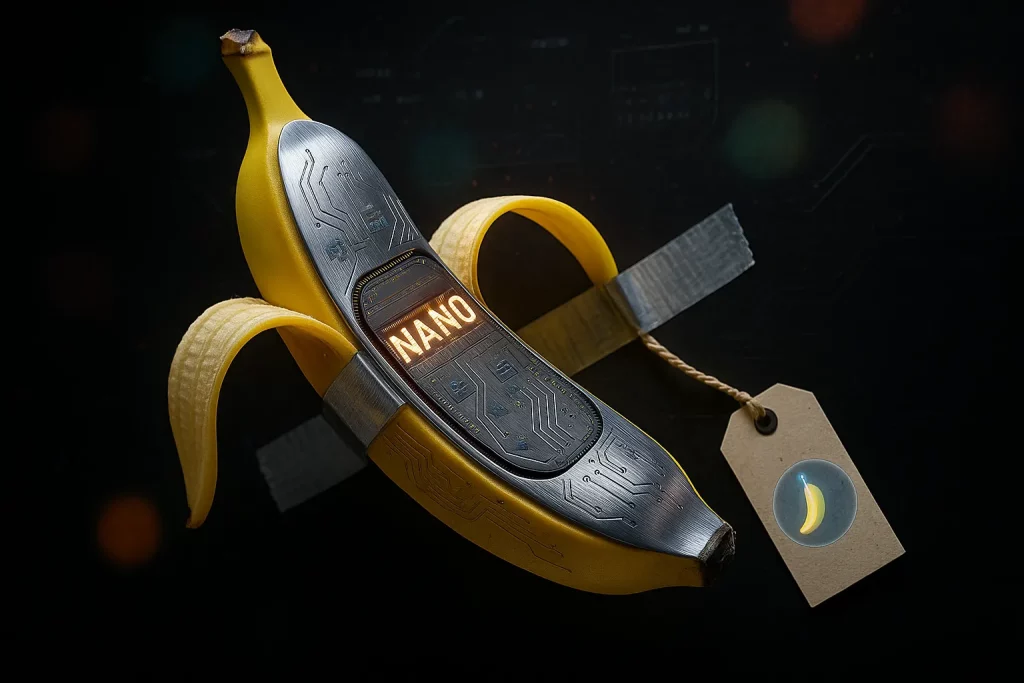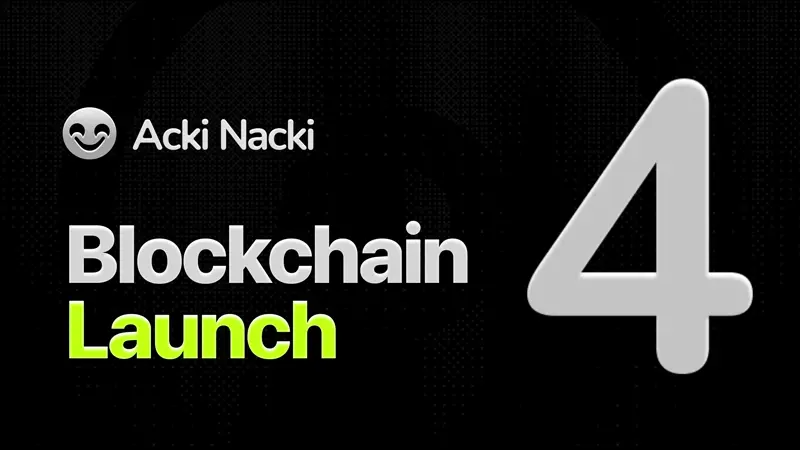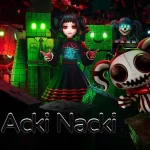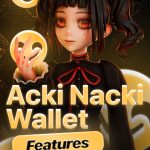Update, Aug 27, 2025, Google AI Studio posted that “nano banana is here”, pointing to Gemini 2.5 Flash Image (preview).
Press confirmations followed, and the model is now rolling out inside the Gemini app for web and mobile and to developers via the Gemini API, Google AI Studio, and Vertex AI.
Free users get up to 100 edits per day, paid tiers get more, and yes, this is the same “banana” that topped LMArena.
A banana walks into LM Arena…
No, it’s not a start of a joke.
Nobody announced it. No paper. No repo. Just a weird model alias, “nano-banana”, quietly showing up in LMArena’s image battles and… yeah.
People fed it prompts, it spat back edits that looked like reality had blinked for a second.
Business Insider even tested it in LMArena and said it was “pretty great” at following prompts, with occasional spelling faceplants. Still no official owner. Internet points to Google.
Google says nothing, only emojis on X and a banana taped to a wall by two Googlers. Cute. Suspicious. Very Google.
What it is
Nano Banana is an image model that does two things well at once, generate and edit, with shockingly strong identity and scene consistency. People edit faces and the face stays the same, change clothes and the fabric remembers physics, rotate a head and the lighting still works.
The vibe from community tests is simple, it follows instructions without babying, often on the first pass.
“Nano” matches Google’s on-device Gemini Nano brand, which is real and official.
That fuels the theory that this might be a Google family member or sibling tech. But again, no confirmation.
What we actually saw it’s capable
- Identity preservation: Edits that keep the original person or object stable across changes, something many models still fumble. Users keep calling that out as the standout trick.
- Instruction following: Fewer prompt contortions, better adherence to “put this here, shift that there.”
- Text-only edits, no manual masks: It seems to figure out the region to modify from your words. That is why non-pros are rumoring “photoshop is dead” on social. Creative Bloq
- 3D-ish consistency: Turning heads, keeping lighting and perspective coherent. Hard trick, great party.
- Where to try: Mostly “battle” mode on LMArena, plus scattered fronts that syndicate or mimic it. No official API. No official product page. Yet. Redditflux-ai.io
- Weak spots: Text rendering still goofy sometimes. Some results are cherry-picked by excited humans, because of course they are. Business Insider
Is it Google or not
Evidence trail, such as it is:
- Banana emoji from Google AI Studio’s Logan Kilpatrick on Aug 19.
- A tasteful art-history banana from a DeepMind PM the same day.
- Press roundups connecting those posts to the mysterious model.
This is marketing smoke, not a press release. If you trade your money or workflow on emoji-based due diligence, you deserve the hangover.
What makes it different
Consistency over chaos. Many image models still “re-imagine” the whole image when you ask for a small change. Banana acts more like a selective editor.
Users report it modifies parts and respects the rest, which makes brand work, product photos, and portraits actually usable.
Fewer knobs, more correctness. Less prompt gymnastics. Less temperature stuff. You say “rotate the subject 20 degrees, add a shadow, keep the jacket” it often does just that.
This is a user-level effect, not a benchmark, but the signal repeats across demos.
Speed that feels practical. Reviewers call it fast. If it is built on tech designed for on-device or low-latency pipelines. Again, no official latency spec, only demos.
The “Nano” breadcrumb. Google’s Gemini Nano is a real, shipping, on-device family. If Nano Banana is a cousin, expect aggressive optimization for mobile and privacy workflows.
If it is not, they at least picked a name that piggybacks this mental model.
Better than what, exactly
I ran comparisons across what the community posted.
GPT-Image-1: people still say OpenAI renders text and fine graphic design constraints well, but Banana looks stronger at photoreal edits with identity stability.
Not always, but often enough to cause noise. Anecdotal, not lab-grade.
Midjourney v6 and friends: Midjourney wins on stylization and raw vibe. Banana’s advantage shows when you want reality anchored, not art exploded.
Fashion swaps, product replacement, subtle lighting fixes, multi-panel B-roll style prompts.
Flux / Qwen Image Edit: commenters say Flux and Qwen also do “edit only the part” tricks, but Banana feels more obedient and spatially aware right now. Edge today, not guaranteed tomorrow. The gap can close fast in this market.
What it is not
- Not officially released. No docs. No safety card. No license. If you are a business, that matters more than the wow.
- Not a Photoshop killer, not yet. Precision retouch, layer logic, and manual control are still king. This model makes casual edits trivial and pro workflows faster, it does not replace deep craft.
A tiny test plan you can steal
Until there is an API, use LMArena battles to sanity-check claims.
- Portrait edit: “Change lighting to warm tungsten, add soft rim light on left, keep freckles unchanged.” Check skin texture, hair edges, background stability.
- Product swap: “Replace this shoe with the same model in matte navy, keep reflections, keep angle.” Inspect shadows and highlights for lies.
- Pose change: “Turn subject to face camera, keep background untouched.” Look for warped backgrounds, cloned artifacts.
- Text stress: “Add a small ‘SUMMER SALE’ tag on the box.” It may still misspell. Note that.
The Dapp verdict
- If different? Yes, in the places that matter for real-photo editing, identity lock, spatial obedience, minimal babysitting.
- Better or worse? Better at surgical edits and instruction following, worse at perfect graphic design control and explainability since there are no tools, no masks, no sliders exposed to you.
- Should you care? If you shoot products, do brand kits, or iterate social ads, this could cut hours into minutes. If you paint worlds, Midjourney still dances. If you need legal clarity and SLAs, wait for the official banner.
Score for v0 rumor-era Banana
Usefulness for photo edits, 9/10
Reliability, 7/10, early days, occasional weirdness
Enterprise readiness, 3/10, there is no product yet
Fun factor, 11/10, it makes normies feel like retouchers
Post-credits, the add-on
If this really is Google and the “Nano” in the name is not a meme, expect integration into Photos or Pixel workflows first. Gemini Nano already is on device, quietly doing work where latency and privacy are king. If Banana drops there, the camera in your pocket will get a brain upgrade.
No press release needed, only a toggle.
Then a terms of service.
Then a headline about the death of design.
We will still need taste. Sorry.
Links i used
- https://www.businessinsider.com/bananas-google-viral-ai-model-2025-8
- https://www.creativebloq.com/ai/ai-art/what-is-nano-banana-and-is-it-really-the-end-of-photoshop
- https://www.bgr.com/1947324/nano-banana-ai-image-generator-10-examples/
- https://tech.yahoo.com/ai/articles/ai-photo-tool-nano-banana-180718496.html
- https://www.reddit.com/r/OpenAI/comments/1mx8up2/nano_banana_delivers_prolevel_edits_in_seconds/
- https://www.reddit.com/r/singularity/comments/1muw88f/showcase_of_the_new_nanobanana_model_on_lmarena/
- https://www.youtube.com/watch?v=XOhGWdcdF9I
- https://www.youtube.com/watch?v=PTB9NUAbopI
- https://deepmind.google/models/gemini/nano/
- https://developer.android.com/ai/gemini-nano
- https://android-developers.googleblog.com/2025/08/the-latest-gemini-nano-with-on-device-ml-kit-genai-apis.html
(Yes, I know, rumors age badly. If Google actually names it “Not Banana” next week, we will laugh, rewrite, and move on.)





